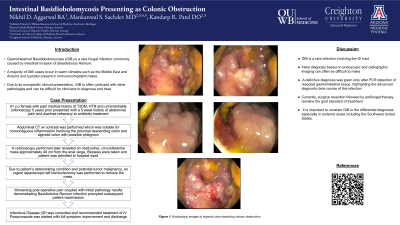Tuesday Poster Session
Category: Colon
P3061 - Intestinal Basidiobolomycetes Presenting as Colonic Obstruction
Tuesday, October 24, 2023
10:30 AM - 4:00 PM PT
Location: Exhibit Hall

Has Audio

Nikhil Aggarwal, BA
Oakland University William Beaumont School of Medicine
Rochester Hills, MI
Presenting Author(s)
Nikhil Aggarwal, BA1, Kandarp Patel, DO2, Mankanwal S. Sachdev, MD3
1Oakland University William Beaumont School of Medicine, Rochester Hills, MI; 2AZCDH, Phoenix, AZ; 3AZCDH, Paradise Valley, AZ
Introduction: Gastrointestinal Basidiobolomycosis (GIB) is a rare fungal infection commonly caused by intestinal invasion of Basidiobolus Ranrum. A majority of GIB cases occur in warm climates such as the Middle East and Arizona and typically present in immunocompetent males. Due to its nonspecific clinical presentation, GIB is often confused with other pathologies and can be difficult for clinicians to diagnose and treat. Herein, we report a case of GIB that presented as an obstructing colon tumor in a 61 y.o female with a 5 week history of abdominal pain.
Case Description/Methods: A 61 y.o. female w/ PMH of T2DM, HTN, and unremarkable colonoscopy 5 years prior presented to our ER with a 5 week history of abdominal pain and diarrhea refractory to antibiotic treatment. An abdominal CT w/contrast was performed which was notable for multiple noncontiguous segments of colonic inflammation involving the proximal aspect of the descending colon and sigmoid colon along with possible phlegmon. A colonoscopy performed one week later revealed an obstructing, circumferential mass in the sigmoid colon approximately 40 cm from the anal verge. Due to the patient's deteriorating clinical condition and potential tumor malignancy, the patient underwent an urgent laparoscopic left hemicolectomy to remove the mass. The patient was discharged and initial pathology results demonstrated necrotizing granulomatous inflammation with thin walled broad fungal hyphal forms consistent with zygomycetes/basidiobolomycosis infection. She had worsening post operative pain prompting readmission to the hospital. Further investigation of pathology specimens via fungal PCR confirmed infection by Basidiobolomycosis. ID was consulted and recommended treatment with IV Posaconazole was started. Patient noted significant improvement in symptoms and successfully transitioned to PO a day prior to discharge.
Discussion: GIB is a rare infection involving the GI tract in immunocompetent individuals. We report a case in Arizona of GIB presenting as an obstructive colon mass. Initial diagnosis based on endoscopic and radiographic imaging can often be difficult to make. A definitive diagnosis was given only after PCR detection of resected gastrointestinal tissue, highlighting the advanced diagnostic time course of this infection. Currently, surgical resection followed by antifungal therapy remains the gold standard of treatment. It is important to consider GIB in the differential diagnoses especially in endemic areas including the Southwest United States.
Disclosures:
Nikhil Aggarwal, BA1, Kandarp Patel, DO2, Mankanwal S. Sachdev, MD3. P3061 - Intestinal Basidiobolomycetes Presenting as Colonic Obstruction, ACG 2023 Annual Scientific Meeting Abstracts. Vancouver, BC, Canada: American College of Gastroenterology.
1Oakland University William Beaumont School of Medicine, Rochester Hills, MI; 2AZCDH, Phoenix, AZ; 3AZCDH, Paradise Valley, AZ
Introduction: Gastrointestinal Basidiobolomycosis (GIB) is a rare fungal infection commonly caused by intestinal invasion of Basidiobolus Ranrum. A majority of GIB cases occur in warm climates such as the Middle East and Arizona and typically present in immunocompetent males. Due to its nonspecific clinical presentation, GIB is often confused with other pathologies and can be difficult for clinicians to diagnose and treat. Herein, we report a case of GIB that presented as an obstructing colon tumor in a 61 y.o female with a 5 week history of abdominal pain.
Case Description/Methods: A 61 y.o. female w/ PMH of T2DM, HTN, and unremarkable colonoscopy 5 years prior presented to our ER with a 5 week history of abdominal pain and diarrhea refractory to antibiotic treatment. An abdominal CT w/contrast was performed which was notable for multiple noncontiguous segments of colonic inflammation involving the proximal aspect of the descending colon and sigmoid colon along with possible phlegmon. A colonoscopy performed one week later revealed an obstructing, circumferential mass in the sigmoid colon approximately 40 cm from the anal verge. Due to the patient's deteriorating clinical condition and potential tumor malignancy, the patient underwent an urgent laparoscopic left hemicolectomy to remove the mass. The patient was discharged and initial pathology results demonstrated necrotizing granulomatous inflammation with thin walled broad fungal hyphal forms consistent with zygomycetes/basidiobolomycosis infection. She had worsening post operative pain prompting readmission to the hospital. Further investigation of pathology specimens via fungal PCR confirmed infection by Basidiobolomycosis. ID was consulted and recommended treatment with IV Posaconazole was started. Patient noted significant improvement in symptoms and successfully transitioned to PO a day prior to discharge.
Discussion: GIB is a rare infection involving the GI tract in immunocompetent individuals. We report a case in Arizona of GIB presenting as an obstructive colon mass. Initial diagnosis based on endoscopic and radiographic imaging can often be difficult to make. A definitive diagnosis was given only after PCR detection of resected gastrointestinal tissue, highlighting the advanced diagnostic time course of this infection. Currently, surgical resection followed by antifungal therapy remains the gold standard of treatment. It is important to consider GIB in the differential diagnoses especially in endemic areas including the Southwest United States.
Disclosures:
Nikhil Aggarwal indicated no relevant financial relationships.
Kandarp Patel indicated no relevant financial relationships.
Mankanwal Sachdev: Boston Scientific – Consultant. Medtronic – Consultant. Microtech – Consultant.
Nikhil Aggarwal, BA1, Kandarp Patel, DO2, Mankanwal S. Sachdev, MD3. P3061 - Intestinal Basidiobolomycetes Presenting as Colonic Obstruction, ACG 2023 Annual Scientific Meeting Abstracts. Vancouver, BC, Canada: American College of Gastroenterology.
